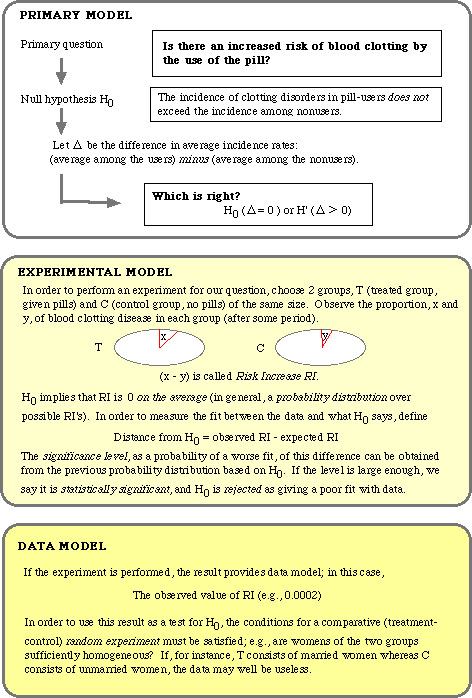![]()

Chapter 5. Models of Experimental Inquiry, 141-144
It is very hard to try to understand (anything!) without specific examples to which the distinction is applied. The example Mayo gives is the causal relation between taking pills and blood-clotting: Is there an increased risk of developing a blood-clotting disorder among women who use the pill?
See the figure.

What is the use of this hierarchy of models? Mayo asserts that this helps solving the Duhemian problems, by presenting a realistic picture of scientific practice. In our example, the target of the test is supposed to be the null hypothesis H0, but it may be the case that auxiliary hypothesis A (e.g. that the auxiliary factors are not responsible for the observed results) is involved. If the observed results show a risk increase RI that is statistically significant, what should we do? Mayo's answer is this:
In our framework, the question of hypothesis A arises at the stage of checking whether the data obey the assumptions of the experiment. Separate work to show that the auxiliaries are responsible is required before disconfirming A. ... one's belief in the hypothesis that the pill does not increase the risk of clotting disorders simply does not enter into the separate statistical tests to check whether the influence of each auxiliary factor is responsible for the observed effect.
This is not to say that background theories or, if one likes, background beliefs, play no role in the experimental inference. ... But whereas specifying experiments may well reflect subjective beliefs, pragmatic factors, or something else, what the results do and do not indicate is not a matter of subjective beliefs. By reporting the features of the test specifications, researchers enable others to scrutinize a result, to perhaps find experimental assumptions violated or a result misinterpreted or irrelevant (to some primary question that interests them). (148)
In this way, Mayo argues, we can solve the Duhemian problems. In a word, checking the null hypothesis (in the experimental model) and checking auxiliaries (in the data model) can be separated within the hierarchy.™@For another attempt to solve the Duhemian problems (in space-time theories), see Gruenbaum on Duhem and Einstein.
INDEX- CV- PUBLS.- PICT.ESSAYS- ABSTRACTS- INDEX™ELAPLACE- OL.ESSAYS-CRS.MATERIALS
Last modified Jan. 26, 2003. (c) Soshichi Uchii